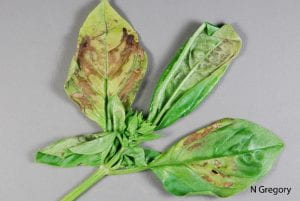Nancy Gregory, Plant Diagnostician; ngregory@udel.edu and Kate Everts, Vegetable Pathologist, University of Delaware and University of Maryland; keverts@umd.edu
Downy mildew on basil is currently widespread in the eastern U.S., after being distributed to “big box” garden centers by a major supplier. The disease has been confirmed in Sussex and New Castle counties in Delaware, and in Carroll and Montgomery counties in Maryland. Because infected plants were found in garden centers of big-box stores, it is likely that the disease has spread widely. It has also been reported this summer in VA, WV, KY, CT, TN, and WI.
Description and Damage
The disease is caused by a fungus-like Oomycete pathogen that only goes to basil. Symptoms include leaf yellowing, followed by dark lesions, and leaves of this popular herb become unusable. Spores are produced on the undersides of leaves, but can be confused with other fungi, dust and potting material. Therefore, confirmation is dependent on microscopic observation. Basil downy mildew spores are produced in abundance and can be spread on by air currents, as well as on infected leaf material. The pathogen may also be seed-borne, and asymptomatic plants may develop symptoms after sale.
Control
All sweet basil varieties are susceptible, but research is ongoing to test for sources of resistance. Control on plants in gardens may be accomplished by using phosphorus acid salts fungicides such as ProPhyt or K-Phite. The bio-rational fungicide, Actinovate, is also labeled on herbs, containing the bio-control micro-organism, Streptomyces. Any chemicals should be applied preventatively, according to the label, and may not provide good control once the disease can be seen sporulating on leaf tissue. (Any reference to trade names is for information only and does not imply endorsement.) Cultural practices to reduce leaf wetness and humidity should be used to help manage the disease. Light inhibits spore production, so light may be used to aid in control in high tunnels or greenhouse situations.
The pathogen probably will not over-winter in Delaware, but could over-winter in a greenhouse or sheltered location.
Basil downy mildew symptoms

